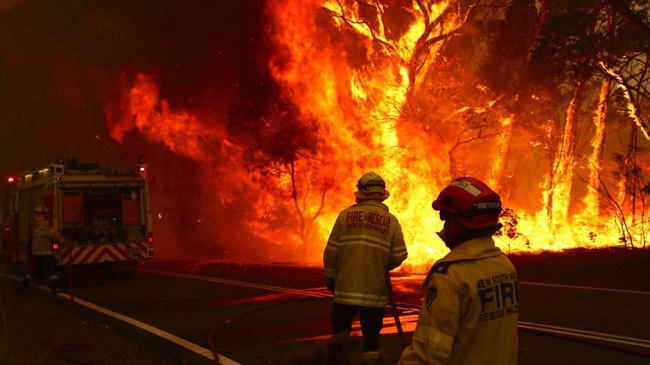Australia urged nearly a quarter of a million people to evacuate their homes on Friday, January 10, 2020 and prepared military backup as authorities said the next few hours could be “very, very challenging” even as rain poured down in some parts.

Defence personnel stood ready to move to bushfire grounds if conditions became extreme, Prime Minister Scott Morrison said, as soaring temperatures and erratic winds create dangerous conditions.
“Even with rain in Melbourne, even with forecast better conditions next week, there is a long way to go in what has been an unprecedented fire event…and.
“Of course, we know that we have many weeks of the fire season to run,” Daniel Andrews, the Premier of Victoria, told a televised briefing.
While the winds are expected to move through by Saturday morning, Andrews urged residents to stay on high alert and leave the community “if you are told to”.
Authorities sent emergency texts to 240,000 people in Victoria, telling them to leave.
People in high-risk regions in New South Wales and South Australia were also urged to think about leaving, but officials did not say how many.
Since October, 27 people have been killed and thousands subjected to repeat evacuations as huge and unpredictable fires scorched more than 10.3 million hectares (25.5 million acres) of land, an area roughly the size of South Korea.
In the coastal town of Eden in New South Wales, where the alert status was upgraded to ‘watch and act’ on Friday evening, smoke filled the horizon as winds blew smoke and ash.
Shereen and Kim Green, who live on a farm with three houses and 50 cattle just outside Eden, were racing to fill two 1,000-litre tanks of water.
“This is to put out the spot fires and we’ll be staying up all night to defend our property,” said Shereen, as the wind shook her utility vehicle.
“We’re taking the opportunity while we can.”
Sitting under the town’s watchtower,
another resident Robyn Malcolm said: “If it all goes wrong, we’ll dash down to
the wharf and get on a tugboat.”
Of 160 fires ablaze across New South Wales (NSW), about 46 were uncontained.
Two were burning at an ‘emergency level’;
eight blazes were in the “watch and act” category, with the rest at the
“advice” level, the lowest alert rating.
Neighbouring Victoria had 36 fires, with more than 1.3 million hectares burned.
Nine fires were at an emergency level.
Victoria emergency services minister Lisa Neville said some communities had been provided with large containers of satellite phones, baby formula, food, nappies, and torches in case they are cut off.
Westpac estimated total bushfire losses to date at about A$5 billion (US$3.4 billion), higher than the 2009 bushfires in Victoria but smaller than the Queensland floods in 2010/11.
Health officials in New South Wales urged extra precautions to avoid heat-related illnesses.
